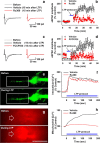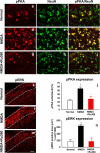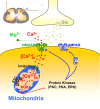Mitochondrial Ca(2+) uptake is essential for synaptic plasticity in pain
- PMID: 21900577
- PMCID: PMC3179262
- DOI: 10.1523/JNEUROSCI.3093-11.2011
Mitochondrial Ca(2+) uptake is essential for synaptic plasticity in pain
Abstract
The increase of cytosolic free Ca(2+) ([Ca(2+)](c)) due to NMDA receptor activation is a key step for spinal cord synaptic plasticity by altering cellular signal transduction pathways. We focus on this plasticity as a cause of persistent pain. To provide a mechanism for these classic findings, we report that [Ca(2+)](c) does not trigger synaptic plasticity directly but must first enter into mitochondria. Interfering with mitochondrial Ca(2+) uptake during a [Ca(2+)](c) increase blocks induction of behavioral hyperalgesia and accompanying downstream cell signaling, with reduction of spinal long-term potentiation (LTP). Furthermore, reducing the accompanying mitochondrial superoxide levels lessens hyperalgesia and LTP induction. These results indicate that [Ca(2+)](c) requires downstream mitochondrial Ca(2+) uptake with consequent production of reactive oxygen species (ROS) for synaptic plasticity underlying chronic pain. These results suggest modifying mitochondrial Ca(2+) uptake and thus ROS as a type of chronic pain therapy that should also have broader biologic significance.
Figures







Similar articles
-
N-methyl-D-aspartate receptor-mediated mitochondrial Ca(2+) overload in acute excitotoxic motor neuron death: a mechanism distinct from chronic neurotoxicity after Ca(2+) influx.J Neurosci Res. 2001 Mar 1;63(5):377-87. doi: 10.1002/1097-4547(20010301)63:5<377::AID-JNR1032>3.0.CO;2-#. J Neurosci Res. 2001. PMID: 11223912
-
Presenilins regulate synaptic plasticity and mitochondrial calcium homeostasis in the hippocampal mossy fiber pathway.Mol Neurodegener. 2017 Jun 15;12(1):48. doi: 10.1186/s13024-017-0189-5. Mol Neurodegener. 2017. PMID: 28619096 Free PMC article.
-
Theta-Burst Stimulation of Primary Afferents Drives Long-Term Potentiation in the Spinal Cord and Persistent Pain via α2δ-1-Bound NMDA Receptors.J Neurosci. 2022 Jan 19;42(3):513-527. doi: 10.1523/JNEUROSCI.1968-21.2021. Epub 2021 Dec 8. J Neurosci. 2022. PMID: 34880118 Free PMC article.
-
Hippocampal long-term synaptic plasticity and signal amplification of NMDA receptors.Crit Rev Neurobiol. 2006;18(1-2):71-84. doi: 10.1615/critrevneurobiol.v18.i1-2.80. Crit Rev Neurobiol. 2006. PMID: 17725510 Review.
-
Regulation of neuronal PKA signaling through AKAP targeting dynamics.Eur J Cell Biol. 2006 Jul;85(7):627-33. doi: 10.1016/j.ejcb.2006.01.010. Epub 2006 Feb 28. Eur J Cell Biol. 2006. PMID: 16504338 Review.
Cited by
-
Psychostimulants influence oxidative stress and redox signatures: the role of DNA methylation.Redox Rep. 2022 Dec;27(1):53-59. doi: 10.1080/13510002.2022.2043224. Redox Rep. 2022. PMID: 35227168 Free PMC article. Review.
-
Spinal antinociceptive effect of the PnTx4(5-5) peptide is possibly mediated by the NMDA autoreceptors.J Venom Anim Toxins Incl Trop Dis. 2024 Nov 25;30:e20230103. doi: 10.1590/1678-9199-JVATITD-2023-0103. eCollection 2024. J Venom Anim Toxins Incl Trop Dis. 2024. PMID: 39686943 Free PMC article.
-
Microalgae and exercise: from molecular mechanisms and brain health to clinical perspectives in the context of 3P medicine.EPMA J. 2025 Mar 26;16(2):351-386. doi: 10.1007/s13167-025-00405-8. eCollection 2025 Jun. EPMA J. 2025. PMID: 40438495 Review.
-
Calcium Signalling in Breast Cancer Associated Bone Pain.Int J Mol Sci. 2022 Feb 8;23(3):1902. doi: 10.3390/ijms23031902. Int J Mol Sci. 2022. PMID: 35163823 Free PMC article. Review.
-
Crosstalk between Calcium and ROS in Pathophysiological Conditions.Oxid Med Cell Longev. 2019 Apr 24;2019:9324018. doi: 10.1155/2019/9324018. eCollection 2019. Oxid Med Cell Longev. 2019. PMID: 31178978 Free PMC article. Review.
References
-
- Brookes PS, Yoon Y, Robotham JL, Anders MW, Sheu SS. Calcium, ATP, and ROS: a mitochondrial love-hate triangle. Am J Physiol Cell Physiol. 2004;287:C817–C833. - PubMed
-
- Coderre TJ. Contribution of protein kinase C to central sensitization and persistent pain following tissue injury. Neurosci Lett. 1992;140:181–184. - PubMed
-
- Cox B. Calcium channel blockers and pain therapy. Curr Rev Pain. 2000;4:488–498. - PubMed
Publication types
MeSH terms
Substances
Grants and funding
LinkOut - more resources
Full Text Sources
Medical
Miscellaneous
